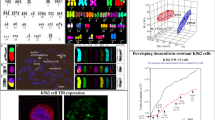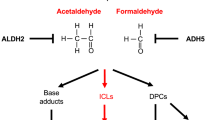Summary
In extension of a previous study, spontaneous and clastogen-induced chromosome damage was analyzed in cultures of peripheral blood lymphocytes from six further patients with Werner syndrome (WS) and six healthy controls. In addition, sister chromatid exchange (SCE) was estimated in four of these cases. Lymphocytes of patients with various other diseases were used for another series of control experiments. Diepoxybutane (DEB), 4-nitroquinoline-1-oxide (NQO), and bleomycin (BLM) were the standard clastogens throughout the study. While the spontaneous frequency of chromosomal breakage was significantly higher in lymphocytes from all the patients than in the control cells, the basis SCE rate was un-affected in WS cells. Sensitivity of WS cells to the chromosome-damaging action of BLM did not differ from that of control cells, and their sensitivity to DEB was slightly greater than that of control lymphocytes. However, NQO induced a more distinct increase of both break and interchange aberrations in the WS cells than in control cells or cells from patients with other diseases. This effect was not found for the SCE rate. Our data demonstrate the exceptional cytogenetic features of this syndrome: Although the spontaneous and the DEB- and NQO-induced chromosomal breakage rate would suggest that WS is like a classic chromosomal instability syndromes, the lack of sensitivity of WS cells to bleomycin and their stable SCE frequency compared with that of control cells clearly delimitate this syndrome from other entities.
Similar content being viewed by others
References
Auerbach AD, Wolman SR (1983) Carcinogen-induced chromosome breakage in chromosome instability syndromes. Cancer Genet Cytogenet 1:21–28
Bartram CR, Koske-Westphal T, Passarge E (1976) Chromatid exchanges in ataxia telangiectasia, Bloom's syndrome, Werner's syndrome, and xeroderma pigmentosum. Ann Hum Genet 40:79–86
Cohen MM, Simpson, SJ, Pazos L (1981) Specificity of bleomycin-induced cytotoxic effects on ataxia telangiectasia lymphoid cell lines. Cancer Res 41:1817–1823
Cohen MM, Frutchman CE, Simpson SJ, Boughman JA (1983) Chemical clastogenicity in lymphoid cell lines of chromosomal instability syndromes. Cancer Genet Cytogenet 10:267–276
Darlington GJ, Dutkowski R, Brown WT (1981) Sister chromatid exchange frequency in progeria and Werner syndrome patients. Am J Hum Genet 33:762–766
Dutkowski RT, Lesh R, Staiano-Coico L, Thaler H, Darlington GJ, Weksler ME (1985) Increased chromosomal instability in lymphocytes from elderly humans. Mutat Res 149:505–512
Epstein CJ, Martin GM, Schultz AL, Motulsky AG (1985) Werner's syndrome: a review of its symptomatology, natural history, pathologic features, genetics, and relationship to the natural ageing process. In: Salk D, Fujiwara Y, Martin GM (eds) Werner's syndrome and human ageing. Plenum Press, New York London, pp 57–120
Fujiwara Y, Kano Y, Ichihashi M, Nakao Y, Matsumara T (1985) Abnormal fibroblast ageing and DNA replication in the Werner syndrome. In: Salk D, Fujiwara Y, Martin GM (eds) Werner's syndrome and human ageing. Plenum Press, New York London, pp 459–477
Gebbart E, Kappauf H (1978) Bleomycin and sister chromatid exchange in human lymphocyte chromosomes. Mutat Res 58:121–124
Gebhart E, Kysela D, Matthe H, Nikol M (1985a) Cytogenetic analyses utilizing various clastogens in two sibs with Fanconi anemia, their relatives, and control individuals. Hum Genet 69:309–315
Gebhart E, Schinzel M, Ruprecht KW (1985b) Cytogenetic studies using various clastogens in two patients with Werner syndrome and control individuals. Hum Genet 70:324–327
Hanaoka F, Yamada M, Takeuchi F, Goto M, Miyamoto T, Hori T (1985) Autoradiographic studies of DNA replication in Werner's syndrome cells. In: Salk D, Fujiwara Y, Martin GM (eds) Werner's syndrome and human ageing. Plenum Press, New York London, pp 439–457
Heddle JA, Krepinsky AB, Marshall RR (1983) Cellular sensitivity to mutagens and carcinogens in the chromosome-breakage and other cancer-prone syndromes. In: German J (ed) Chromosome mutation and neoplasia. Liss, New York, pp 203–234
Hedner K, Hogstedt B, Kolnig AM, Mark-Vendel E, Strombeck B, Mitelman F (1982) Sister chromatid exchanges and structural chromosome aberrations in relation to age and sex. Hum Genet 62:305–309
Hoehn H, Bryant EM, Au K, Norwood TH, Boman H, Martin GM (1975) Variegated translocation mosaicism in human skin fibroblast cultures. Cytogenet Cell Genet 15:282–298
Huschtscha LI, Thompson KVA, Holliday R (1986) The susceptibility of Werner's syndrome and other human skin fibroblasts to SV 40-induced transofrmation and immortalization. Proc R Soc Lond [Biol] 229:1–12
Jomas JB, Ruprecht KW, Schmitz-Valckenberg P, Brambring D, Platt D, Gebhart E, Schachtschabel DO, Naumann GOH (1987) Ophtalmic surgical complications in Werner's syndrome: report of 18 eyes of nine patients. Ophthalmol Surg 18:760–764
Lehmann AR, Stevens S (1979) The response of ataxia telangiectasia cells to bleomycin. Nucleic Acids Res 6:1953–1960
Nikaido O, Nishida T, Shima A (1985) Cellular mechanisms of ageing in the Werner syndrome. In: Salk D, Fujiwara Y, Martin GM (eds) Werner's syndrome and human ageing. Plenum Press, New York London, pp 421–438
Nordenson I (1977) Chromosome breaks in Werner's syndrome and their prevention in vitro by radical-scavenging enzymes. Hereditas 87:151–154
Ray JH, German J (1983) The cytogenetics of the “chromosome breakage syndromes”. In: German J (ed) Chromosome mutation and neoplasia. Liss, New York, pp 135–167
Salk D, Au K, Hoehn H, Martin GM (1981) Cytogenetics of Werner syndrome cultured skin fibroblasts: variegated translocation mosaicism. Cytogenet Cell Genet 30:92–107
Salk D, Fujiwara Y, Martin GM (eds) Werner's syndrome and human ageing. Plenum Press, New York London
Scappaticci S, Cermele D, Fraccaro M (1982) Clonal structural chromosomal rearrangements in primary fibroblast cultures and in lymphocytes of patients with Werner's syndrome. Hum Genet 62: 16–24
Scudiero DA, Polinsky RJ, Brumback RA, Tarone RE, Nee LE, Robbins JH (1986) Alzheimer disease fibroblasts are hypersensitive to the lethal effects of a DNA-damaging chemical. Mutat Res 159:125–131
Taylor AMR, Rosney CM, Campbell JB (1979) Unusual sensitivity of ataxia telangiectasia cells to bleomycin. Cancer Res 39:1046–1050
Author information
Authors and Affiliations
Rights and permissions
About this article
Cite this article
Gebhart, E., Bauer, R., Raub, U. et al. Spontaneous and induced chromosomal instability in Werner syndrome. Hum Genet 80, 135–139 (1988). https://doi.org/10.1007/BF00702855
Received:
Revised:
Issue Date:
DOI: https://doi.org/10.1007/BF00702855




